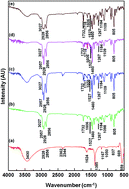Dielectric relaxation and electro-optic response in nano-ceria dispersed ferroelectric liquid crystal nanocomposites: effect of structural deformation and lattice straining
Abstract
The current investigations deal with the effect of concentration of CeO2 nanoparticles (NPs) on physical properties of ferroelectric liquid crystal. Infrared transmission spectroscopy has been used to reveal the mechanism behind significant changes in dielectric behavior and electro-optic parameters of nanocomposites, for the first time, in correlation with structural deformation of functional group present in FLC and lattice straining induced by the NPs. The temperature and frequency dependence of dielectric permittivity exhibits a gradual increase in the dielectric constant with the addition of CeO2 NPs. An increase in the saturated spontaneous polarization (Ps) and switching at a lower bias was also observed in these nanocomposites. IR transmission peaks pertaining to the νC![[double bond, length as m-dash]](https://www.rsc.org/images/entities/char_e001.gif) O and νC–O stretching modes of FLC's ester (RCOOR′) functional group showed a shift in the peak positions and a new weak intensity C
O and νC–O stretching modes of FLC's ester (RCOOR′) functional group showed a shift in the peak positions and a new weak intensity C![[double bond, length as m-dash]](https://www.rsc.org/images/entities/char_e001.gif) O bonded chiral group vibrational mode at 1718 cm−1 was observed after ceria dispersion. These variations are attributed to the coordinated bond formation between planar polar ester C
O bonded chiral group vibrational mode at 1718 cm−1 was observed after ceria dispersion. These variations are attributed to the coordinated bond formation between planar polar ester C![[double bond, length as m-dash]](https://www.rsc.org/images/entities/char_e001.gif) O group and Ce3+ ion through the lone pairs of oxygen and the stress induced by CeO2 NPs present in the interstitial sites of FLC's polar component. These structural distortions facilitate the easy polarizability of FLC molecules with an enhancement in the dielectric constant and Ps values. In addition, the loss profile demonstrates an increase in the frequency and magnitude of ion linked relaxation and Goldstone mode after ceria dispersion, whereas losses on their lower frequency side decreases.
O group and Ce3+ ion through the lone pairs of oxygen and the stress induced by CeO2 NPs present in the interstitial sites of FLC's polar component. These structural distortions facilitate the easy polarizability of FLC molecules with an enhancement in the dielectric constant and Ps values. In addition, the loss profile demonstrates an increase in the frequency and magnitude of ion linked relaxation and Goldstone mode after ceria dispersion, whereas losses on their lower frequency side decreases.


 Please wait while we load your content...
Please wait while we load your content...